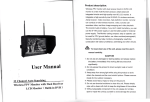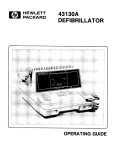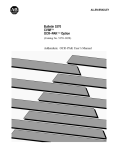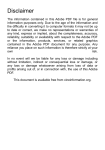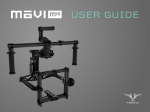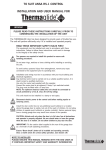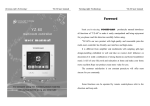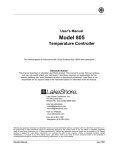Download Canon - Zoom 318 & Zoom 518 - User Manual
Transcript
Disclaimer The information contained in this Adobe PDF file is for general information purposes only. Due to the age of the information and the difficulty in converting it to computer formats it may not be up to date or correct, we make no representations or warranties of any kind, express or implied, about the completeness, accuracy, reliability, suitability or availability with respect to the Adobe PDF or the information, products, services, or related graphics contained in the Adobe PDF document for any purpose. Any reliance you place on such information is therefore strictly at your own risk. In no event will we be liable for any loss or damage including without limitation, indirect or consequential loss or damage, or any loss or damage whatsoever arising from loss of data or profits arising out of, or in connection with, the use of this Adobe PDF. This document is available free from cineinformation.org. r . j' ) I ZOOM 518 ZOOM 318 Follow these simple steps w ........ ... _ 0 __" Ii Film Type Window Shutter Lock Dial, Side Cover Latch ", Shutter Release Button l 4 1 Insert Super 8 film cartridge. ;2 I Remove lens d/8 P. 3 Look through the viewfinder. II I I I , J I , I 5 • 4 Focus, and check whether the exposure meter needle is within the proper range. 5 Rotate zoom"lng lever and adjust size of subject. 8 Press the sh utter release button. F'EA"rURES OF SUPER 8 SYSTEM Film loading ',Canon 518 and 318 incorporate the new Super 8 system. Just slip in the entire Super 8 which holds a continuous 50-foot length of film. , ,Film Speed is Automatically Set ThJ Super 8 cartridges have differently positioned ; j ,';, slot:s according to the type of film. Therefore, when '\film cartridge is slipped into the camera the film l$pe'ed is automatically set and properly exposed can always be shot. Color Temperature ConverskHl Filter A Color Conversion A type filter for conversion of color temperature has been built into the optical system. This enables the use of tungsten type film in daylight. When shooting under artificial light, the conversion can be easily made by simply setting upright the filter conversion pin on the trigger grip. When using daylight film from the beginning, the filter is automatically removed with the insertion of the film cartridge and shooting can be performed in that condition. 7· SPECIFICATIONS Canon Zoom 518 Type: 8mm cine camera, employing Super 8 film cartridge. Cartridge includes both film-load and take-up with automatic setting of film sensitivity. Not necessary to turn cartridge over. Frame Size: 4 x 5.4mm Super 8 size film. Lens: F 1.8 with zooming range of. 9.5-47.5mm. II-component, 14-element construction. Zoom ratio, 1: 5. Zooming is manual by rotation of lens barrel. Zoom range can be extended to super-telephoto (I5.6-78mm) with optional tele-converter. single lens reflex type, including 4 prisms and II-element lens construction. Built-in prism screen focusing system and exposure meter indicat-o-r-.---E:yepiece can be adjust.. ed to the eyesight of photographer. Exposure Meter: Through the lens system, with highly sensitive CdS meter. Batteries for EE systems are two 1.3 V # 625. EE System: Film sensitivity, filming speed and aperture setting are coupled. Aperture warning marks for under- or over-exposure are shown in viewfinder. Automatic adjustment for filters. Film Sensitivity: ASA 25-160 (with Color Conversion A type filter: ASA 16-100). ASA Setting: Exposure meter is set between ASA 25 and 160 with in ran ge of F 1.8 and F 16 at 18 fps when new cartridge is inserted. eCA Filter: Built into Cc:lmera, automatically corrects for exposure of tungsten film for daylight use. Determined by cartridge Used, or manually from outside. Filming speed: 18 fps. Film Advancing: Electrically powered micromotor provides continuous automatic filming of the full 15m (50 ft.) length of the film. Power for Drive: Three 1.5 V penlight batteries. Shutter Release: Mercury battery switch with continuous running and safety lock. Footage Counter: Countable up to 50ft. Automatically resets when new cartridge is inserted. Film Transport Indicator: For checking film advancement. Battery Tester: Push-button actuated indicator shows power I·evel of micromotor batteri'es. Size: 206xl0lx44mm Weight: 1,020 grams (2 lb. 1 oz.) Accessories: Trigger grip 4, tele-converter 1.6x,'etc. Canon Zoom 318 Similar to model 518, with the following exceptions: Lens: F 1.8 with zooming range of 10-30·mm. Zoom ratio, 1: 3. 10-component, 'I2-elemt:nt construction. Focusing: Zone focus system, set by rotation of front lens. . Viewfinder: Contains 4 prisms and 12-element lens construction. Body Color: Brown Size: 204 x 101 x 44mm (8" x 4" x Weight: 1,015 grams (2 lb.) Note: No tele-converter is available for this model. 8 MERCURY BATTERIES 7 Before using Canon Zoom 518 or 318, load it with the two mercury batteries packed in a separate envelope. If the batteries are not inserted, the electric eye (EE) mechanism will not function. Do not leave fingerprints or stains on the mercury batteries. Before inserting the mercury batteries into the camera, wipe all poles clean of all fingerprints or stains with a dry cloth. If this is not done, they may cause corrosion and damage the contact points. When the camera is not to be used for a prolonged period of time, remove the mercury batteries and keep them in a dry place. 9 LOADING OF MERCURY BATTERY 1 2 Remove the outer cover of the mercury battery com partment by turning the outer cover knob to the left. 4 Screw in the inner cover of the mercury battery compartment by turning it to the right. . Remove the inner cover of the mercury battery compartnlent by turning it to the left. 5 Attach the outer cover of the mercury battery compartment. 3 Face the central contact side of the two mercury batteries inwards and insert. .. Be sure the mercury batteries are inserted in the correct direction. Otherwise the EE mechanism will not function properly. 10 . REPLACING OF MERCURY BATTERIES When the sh utter lock dial is set at L the EE circuit is cut off. When set at R or • the electric circuit is switched on and the exposure meter functions. If the exposure meter needle inside the viewfinder does not move after setting the shutter lock dial at R or • and aiming the camera at,the sky or other bright places, the mercury batteries must be reo placed. Use two 1.3V 625 batteries of the same make - equivalent to Mallory RM 625, Eveready E 625, GE National M-ID, Toshiba TH-MC. A mercury battery can ordinarily be used for one and a half years. Be sure to replace the two mercury batteries sim ultaneously. 11 POWER FOR FI,LM DRIVE AND EYEPIECE ADJUSTMENT LOADING OF DRY BATTERIES 1 Loosen the battery compartment opening-closing knob by turning it to the left. 2Remove the top cover by sliding it backwards. 3 • ,nsert three 1.5V penlight (size AA) batteries, with the (+) poles facing towards the front according to the instructions inside the battery compartment. "When the camera is not to be used for a prolonged period of time, remove the dry batteries. 12 EYEPIECE ADJUSTMENT Adjust the eyepiece before putting on the top cover. Aim the camera light or subject. while turning the make adjustments so can be clearly seen. 1 in the direction of a bright Then look into the viewfinder eyepiece adjustment ring and that the aperture stop figures After the eyepiece adjustment has been pleted, slide the top cover back on and then tighten the battery compartment openingclosing knob by turning it to the right. 2 13 BATTERY CHECK After the dry batteries have been loaded, check to see whether the capacity of the batteries is sufficient. Press the red button,a,t the bottom of the camera and check the position of the needle seen in the battery test window. 1 2 If the needle is in the blue zone, it means the batteries have sufficient capacity. If the needle is not in the blue zone, it means the batteries must be' replaced. .. Always check the battery tester before shooting. 14 LOADING AND UNLOADING OF FILM CARTRIDGE Open the side cover by sliding the side cover latch in the direction of the arrow. 1 CANON ZOOM 518 CANON ZOOM 318 Slide the Super 8 film cartridge in, right-sideup, towards the front of the camera, and then set the film cartridge into position by pressing down on it. 2 3 Close the side cover by pressing it. L 15 4 Set the shutter lock dial at R and press the shutter button. If a film winding sound can be heard and the white dot in the film transport indicator revolves, it means preparations for shooting have been completed. .• 5 The super 8 cartridge contains a continuous 50-foot length of film. Stop shooting when the footage counter indicates 50, advance the film further until F appears, and then take out the cartridge. No flip over or rehandling at the end is necessary. .. The footage counter automatically resets to 0 when the cartridge is taken out. 16 SHOOTING FOCUSING-CANON ZOOM 518 CANON ZOOM 518 CANON ZOOM 318 Turn the focusing ring and get the subject into focus. Canon Zoom 518 has a prism screen rangefinder built into the center of the viewfinder. Adjust the focus so that the subject can be seen most clearly through this prism screen rangefinder. The aligned image can be seen more accurately and easily the longer the focal length of the lens. The Out of focus In focus 17 focal point does not chan'ge during zooming. There fore, even when you wish to shoot at I,ow magnifica tion (wide-angle), first focus at maxim um magnification (telephoto) and then return to low magnification and shoot. o o number on the focusing ring to the indicator line on the lens barrel. Focusing can also be easily performed by using the zone focus marks. FOCUSING-CANON ZOOM 318 Estimate the distance from your camera to the subject, and then set the distance by matching the Close distance Medium distance Under-exposure warning mark Aperture scale Long distance Over-exposure warning ,mark Exposure meter needle 2.8 11 16. CANON ZOOM 518 1.8 2.8 CANON ZOOM 318 18 It The zone focus marks are for determining approximate distances. Thus, even when photographing one person, if the distance from the camera to the person is distant, set the needle to the group or scenery marks. Use the distance scale for accurate focusing. ZOOMING The image seen through the viewfinder will change in magnification and the field-af-view will also change by turning the zooming ring. The field-of· view seen through the viewfinder will be exposed on the film in its entirety. When zooming is performed during shooting, any desired zooming effect can be reproduced on the film. f 19 SHUTTER RELEASE BUTTON When the sh utter release button is pressed, shooting starts and the footage counter advances sim ultaneously. The shutter lock dial must be set at R. The shutter lock dial performs the following two functions: Safety Lock When the sh utter lock dial is set at L, the mercury battery circuit is disconnected. The sh utter release button is also locked and prevents inadvertent film advance. 1 20 2 Running Lock Set the shutter lock dial at R and then press the shutter release button. 1'\ ext, if the shutter lock dial is set at., while still pressing the shutter release button, the shutter release button will remain in a pressed down condition even after the finger is taken off the shutter release button. CABLE RELEASE SOCKET When shooting movies using a tripod, use the cable release by screwing it into the cable release socket. -------------------------- --------- Turn while pressing the shutter release button. 21 ACTUAL SHOOTING AND WARNING MARK Canon Zoom 518 and 318 are completely automatic cameras. Exposure adjustments or film speed settings are absolutely unnecessary. Before pressing the shutter release button, aim the camera at the subject and check the position of the exposure meter needle inside the viewfinder. If the needle is pointing somewhere within the range of the aperture scale, you can press the shutter release button. It means the exposure meter needle is CANON ZOOM 518 CANON ZOOM 318 1.3 2.8 4 5.6 8 2.8 I ---- Use N D filter Proper exposu re Insufficient exposure j l tl!l.t!Jl.!J 4 • 5.6 8 .1.8 2.8 4 56 8 11 16 __' I I 22 C pointing to the proper aperture stop. Warning Mark If the exposure meter needle is pointing to either of the red warning marks on both sides of the aperture scale, shooting under proper exposure conditions is impossible. However, if the needle is pointing to the over-exposure warning mark on the left side, shooting will become possible if an ND filter is attached in front of the lens to restrict the light intensity. .. When checking the exposure meter needle, remember that the needle will not move unless the shutter lock dial is set at R. 23 FOLDING TYPE TRIGGER GRIP USE OF ACCESSORIES The shutter can be released while firmly holding the camera by the trigger grip. Use of the trigger grip is recommended for easier handling. 1 Unfold the grip, align the connecting parts of the grip and camera, and attach the grip onto the camera by screwing the attachment screw into the tripod socket. 24 2 3 4 Hold the grip with the right hand and pull the . trigger. The shU'tter will function and the film will advance. When folding the grip, pull the lever down-. wards. TRIGGER GRIP AND COLOR TEMPERATURE CONVERSION When tungsten type film is used for daylight shooting, a Color Conversion A type filter for con- verting the color temperature becomes necessary. To eliminate the trouble of attaching a filter every time you want to shoot in daylight, a Color Conversion A type filter has been built into the optical system of the camera. Thus, for daylight shooting with tungsten type film you use the camera as it is. In case you want to shoot under artificial lighting, stand up the color conversion filter cancellation I L 25 pin of the grip before attaching it onto the camera. This pin will eliminate the built-in Color Conversion from the optical system and shooting under artificial lighting becomes possible. Use of blue lamp is not necessary. You may use ordinary flood lamps or spotlights. .. When the grip "is not attached to the camera, or when the grip is attached to the camera with the color conversion filter cancellation pin folded, the camera is set for daylight shooting. Please bear in mind that proper color photography cannot be performed if the above-mentioned manipulations are not followed correctly. When using black and white or daylight type color films, the Color Conversion A type filter is automatically eliminated with the insertion of the film cartridge. When shooting under artificial lighting with daylight type color film, use blue lamp or Color Conversion B type filter. • 26 REMOTE CONTROL SWITCH With the use of the remote control switch you can operate the camera from a distance. 1 Insert the plug of the remote control switch cord into the remote control switch socket of the camera. 2 Set the shutter lock dial at • t while pressing the shutter release button, to set the camera in running lock condition. 3 When the release button of the remote control switch is pressed down and slid in the direction of the arrow, the film advances and is set into running lock condition. .. When disconnecting the cord of the remote con· trol switch from the camera, be sure to return the shutter lock dial of the camera to R first. If the cord of the remote control switch is discon· nected from the camera before the shutter lock l 27 FILTERS dial is set at-R, the shutter will actuate and the film will start advanci·ng. It The length of the cord for the remote control switch is 8 meters. .. When shooting pictures with the remote control switch, it' is better to check the general conditions of the subject or its immediate surroundings before pressing the shutter release button. Also, cover the eyepiece with a handkerchief or some other conve· nient material to shut out bright light. 48mm screw-in type filters for Canon Zoom 518 and 318, and 72mm screw-in type filters for the converters are availab'le. In the Canon Zoom 518 and 318, the right passing through the optical system of the lens is measur,ed by the TTL system exposure meter. Therefore, any type of filter most suited for a certain purpose can be freely chosen without regard to the exposure factor. 28 TELE"CONVERTER The Canon C-8 Converter is an attachment for the taking lens of Canon Zoom 518 to convert it into a telephoto zoom lens. In this case, the converted magnification range or focal length becomes 15.678 mm, making possible shooting in a wide range, from standard to telephoto. Infinity setting window Lens Speed: Zooming Ratio: Zooming Range: Lens Structure: system. Distance Scale: F 1.8 5 15.6-78 mm 3 components, 5 elements, afocal ft 50 30 20 15 12 10 m 20 10 7 5 4 3 29 'Coating: Filter Size: Cap Size: Hood: Size: Weight: Purple spectra coating 72mm 80mm Built-in type Overall length-75mm. (3") Maximum diameter-80mm (3 1h") 450 grams (16 oz.) Method of Attaching Remove the back cover of the converter and attach the converter over the taking lens of the camera. Turn the lens barrel of the converter and screw the converter into the front panel of the shooting lens. Loosen the tightening screw of the distance ring. 1 2 3 Cap Distance ring tightening screw Back cover Lens barre 30 4 5 8 Turn the distance ring of the converter so that the infinity mark appears in the distance ring window. Fix the distance ring securely with the tightening scr.ew. Pull out the built-in hood. Zooming and· focusing are carried out in the ordinary manner. Without converter 31 48mm CLOSE-UP LENS 450 STORING THE CAMERA The close-up lens is designed for titling, reproduction of documents, photographing of plants and insects, etc. Attach the close-up lens, and when the distance scale is adjusted to 00, the distance from the tip of the lens to the subject is 450m m. Keep the camera avvay from dampness. heat, and dust when storing. Do not place the camera near naphthalene or camphor. While it is not necessary to oil any part of the camera, a periodic overhaul and cleaning will prolong its lifes "When storing the camera in the case, turn the safety lock of the sh utter to L. FIELD-Of-VIEW OF 48mm CLOSE-UP LENS 450 32 PANNING Panning is employed when shooting a picture from one position to another by moving the camera around horizontally to make a continuous shot over a wide area in one sequence. .. Do not move the camera too rapidly in direction, particularly vertically. Use of a tripod is therefore recommended. any "It is important, when shooting panoramic tures, to move the camera at a constant speed. PIC- .When following a fast-moving subject with pan· ning, try to keep the subject in the same position in the viewfinder . 33 CANON P..S CINESTAR S Here is a compact 8mm projector that can show either regular 8mm film or the new Super 8 size. Operation is fully automatic. Insert the film end into the projector, turn the switch, and the film will run completely through and rewind ... with no need for resetting or touching any other switches. It has a fast 15-30mlll F 1.5 zoom lens, 8V 50W mirror lamp, adjustable filming speeds from 10 to 20 fps, a builtin power cord, a plug for a room light and a projection screen built into its side cover. It accepts six different line voltages-IOO, 115, 125, 220 or 240 volts. Focusing Ring Zooming Lever Indicator Line Release Socket Coupled with Trigger Grip Socket for Changing Color Conversion Filter Knob for Outer Cover of Mercury Battery Compartment Tripod Socket. Battery Test Button Film Position Mark Remote Control Switch Socket Film Transport Indicator Footage Counter Battery Tester Battery Compartment Opening-Closing Knob Eyepiece





































